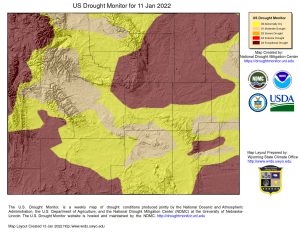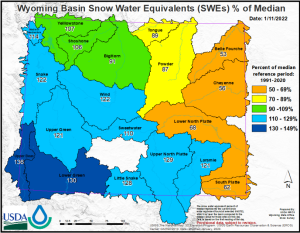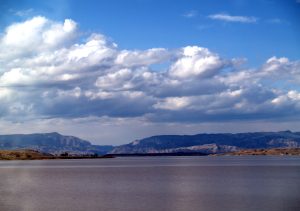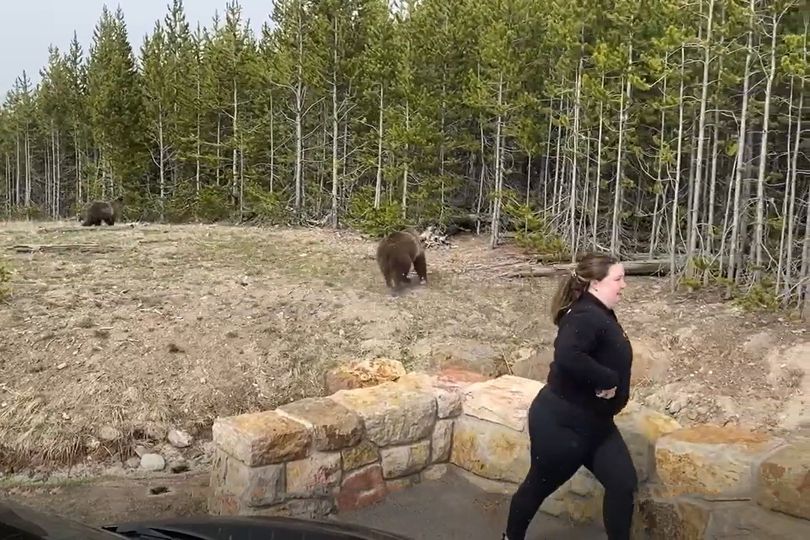No Bighorn Basin Reservoirs Will Reach Capacity in 2022
Written by Andrew-Rossi on January 17, 2022
No basin in the Bighorn Basin is expected to reach capacity in 2022, which isn’t a promising sign for a region that’s already “abnormally dry.”
The Bureau of Reclamation released its snowmelt forecast on Thursday, Jan. 13. In the report, the spring runoff of each river in the Bighorn Basin is calculated to determine how full the basin’s reservoirs will be this summer.
The bureau’s January forecast of the April through July runoff predicted for the Bighorn River Basin is as follows:
Bighorn Lake
- Bighorn Lake – Bighorn River April through July inflow to Bighorn Lake is forecast to be approximately 874,000 acre-feet (a.f.), which is 71% of the 30-year average of 1,228,500 a.f. As of Jan. 1, Bighorn Lake is 87% full.
Buffalo Bill Reservoir
- Shoshone River April through July inflow to Buffalo Bill Reservoir is forecast at 600,000 a.f., which is 81% of the 30-year average of 739,800 a.f. As of Jan. 1, Buffalo Bill is 60% full.
Boysen Reservoir
- Wind River April through July inflow to Boysen Reservoir is forecast at 550,000 a.f., which is 91% of the 30-year average of 604,000 a.f. As of Jan. 1, Boysen Reservoir is 85% full.
Bull Lake Reservoir
- April through July, snowmelt runoff into Bull Lake Reservoir from Bull Lake Creek is expected to be 130,000 a.f., which is 92% of the 30-year average of 142,000 a.f. As of Jan. 1, Bull Lake Reservoir is 58% full.
A reservoir is considered “full” when the pool elevation is at the top of active conservation or joint-use pool. The percentage is based on total reservoir volume below that level.
If these predictions come true, 2022 would be the second consecutive year the Bighorn Basin’s reservoirs do not reach their 30-year average capacities. However, the good news is that every reservoir is expected to be fuller in 2022 than in 2021.
Low reservoirs will not do much for a region that ranges from abnormally dry to experiencing exceptional drought.
The State of Wyoming maintains a Drought Information and Resources website. Every week, a map of drought conditions is produced jointly by several agencies: the National Oceanic and Atmospheric Administration, the U.S. Department of Agriculture, and the National Drought Mitigation Center at the University of Nebraska-Lincoln.
As of Jan. 13, most of the state is either Abnormally Dry or experiencing Exceptional Drought – the most severe drought category. Most Yellowstone and Grand Teton National Parks are classified as in Exceptional Drought as of Jan. 11.
However, the latest snowpack report from the Wyoming Natural Resources Conservation Service is more promising.
The W.N.R.C.S. released the latest report on statewide snowpack in basins across Wyoming. According to the report, every basin in the Bighorn Basin is either at or above median snowpack levels for this time of year.
Regardless of the report, it’s still too early to determine how much water will be available in the Bighorn Basin in 2022. But it seems things will stay fairly dry this spring and summer.




